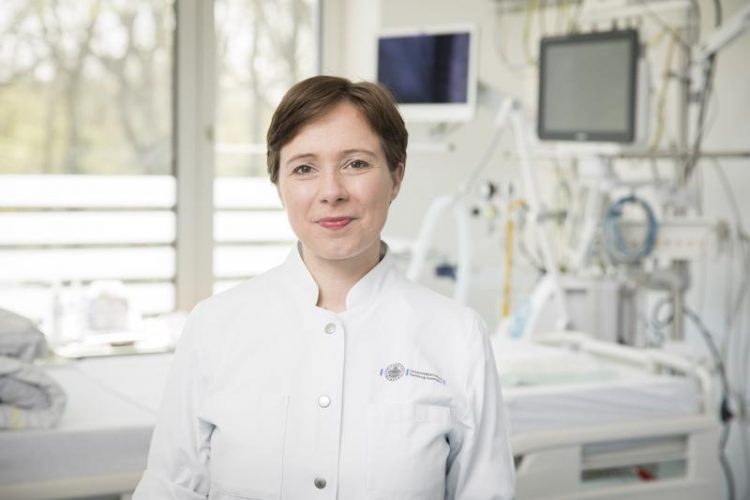First form of therapy for childhood dementia CLN2 developed

Dr. Angela Schulz, the director of the international study Universitätsklinikum Hamburg-Eppendorf
It was possible to stop the illness from progressing for two thirds of the patients. The synthetic enzyme is introduced into the subarachnoid space of the patient via a cathe-ter every 14 days. The scientists have now published their findings in the New England Journal of Medicine.
“So far, the only treatment available to CLN2 patients has been palliative care. This situation has been fundamentally changed by the approval of an enzyme replacement therapy, which was researched by UKE doctors. The study has shown that this is the first form of therapy that can counter the rapid progress of the illness”, said Professor Dr. Ania C. Muntau, Director of the Children's Clinic.
“The earlier CLN2 is diagnosed and treatment is started, the higher the chances are for the therapy to be successful, enabling the children who have acquired the illness to be able to maintain speech for longer and to move independently. But this illness is often discovered too late because it is very rare.
Therefore, I would wish that it would soon be possible in Germany to test all children for CLN2 as part of a screening procedure for newly born”, said Dr. Angela Schulz, the director of the internation-al study and the consultation hour for degenerative brain diseases (focus “Childhood Dementia NCL”) at the Children's Clinic at UKE.
Neuronal ceroid lipofuscinosis (CLN2)
Neuronal ceroid lipofuscinosis (NCL) is a rare illness. The most frequent form is subtype CLN2, where the enzyme tripeptidyl peptidase I (TPP1) is not, or not sufficiently, formed. Thus, the pigment cerois lipofuscin accumulates in the brain cells, which initially lose their function, and ultimately die.
Usually, children with CLN2 develop normally up to the age of three. The only indication can be the delayed development of the children's speech. The first symptoms only become apparent between the second and fourth year. The children have severe epileptic seizures, and language and motor skills regress. In their fifth year, children can no longer sit or stand, and require a wheelchair. They become bedridden, blind, and usually die early.
The international multi-centric study
24 CLN2 patients between the age of three and eight received enzyme replacement therapy with cerliponase alfa every 14 days for at least 96 weeks as part of the international, multi-centric study. The scientists in the study centres in Hamburg, London, Rome and Columbus (USA) documented the development of motor skills and language with a point based system, and compared the course of the disease with 42 historical patients who had not been treated with enzyme replacement.
The his-torical comparative data had previously been collected and evaluated as part of the European Framework Programme (FP7) DEM-CHILD coordinated at UKE by Dr. Schulz. The comparison with untreated children showed that the symptoms of patients who received enzyme replacement thera-py worsened significantly more slowly than those of the historical group of patients: on average, treated patients only lost 0.38, but untreated patients lost 2.0 points per year.
Research of rare illnesses at Children's UKE
Children's UKE, the Werner and Michael Otto University Children's Clinic (Werner und Michael Otto Universitätskinderklinik, Kinder-UKE), treats the most important pediatric illnesses. The particular focus is on severe, rare, complex, and undetermined illnesses such as metabolic disorders, neurologi-cal illnesses, various types of cancer, and liver, kidney, and bone marrow transplants.
Furthermore, the development of innovative treatment methods for children with rare illnesses belongs to the core tasks of the Children's UKE. Thus, the scientists conduct basic research to improve understanding of the mechanisms which cause the illness. They also develop medication and lead international ap-proval studies.
Literature
Schulz A. et al., Study of Intraventricular Cerliponase Alfa for CLN2 Disease, New England Journal of Medicine 2018
DOI: https://doi.org/10.1056/NEJMoa1712649
Please follow this link for photographs on the subject of NCL: www.uke.de/pressebilder
Contact
Dr. Angela Schulz
Klinik und Poliklinik für Kinder- und Jugendmedizin
Universitätsklinikum Hamburg-Eppendorf (UKE)
Martinistraße 52
20246 Hamburg
Telephone: 040 7410-20440
an.schulz@uke.de
Media Contact
More Information:
http://www.uke.deAll latest news from the category: Studies and Analyses
innovations-report maintains a wealth of in-depth studies and analyses from a variety of subject areas including business and finance, medicine and pharmacology, ecology and the environment, energy, communications and media, transportation, work, family and leisure.
Newest articles

Bringing bio-inspired robots to life
Nebraska researcher Eric Markvicka gets NSF CAREER Award to pursue manufacture of novel materials for soft robotics and stretchable electronics. Engineers are increasingly eager to develop robots that mimic the…

Bella moths use poison to attract mates
Scientists are closer to finding out how. Pyrrolizidine alkaloids are as bitter and toxic as they are hard to pronounce. They’re produced by several different types of plants and are…

AI tool creates ‘synthetic’ images of cells
…for enhanced microscopy analysis. Observing individual cells through microscopes can reveal a range of important cell biological phenomena that frequently play a role in human diseases, but the process of…





















